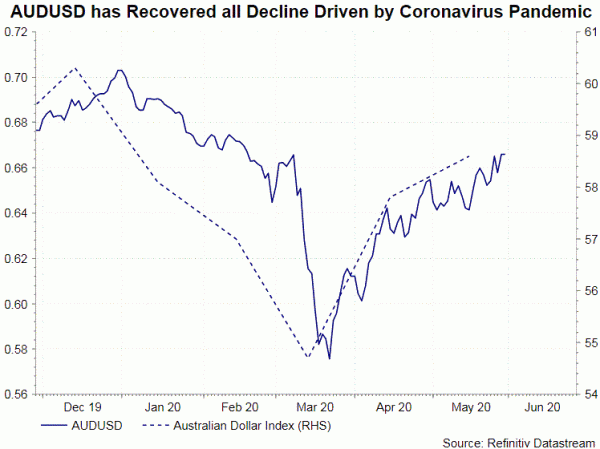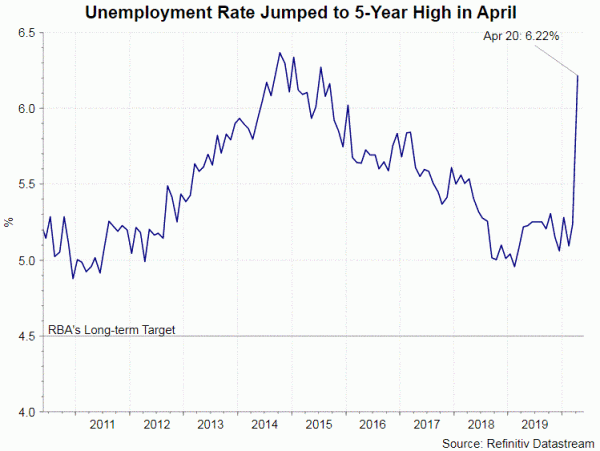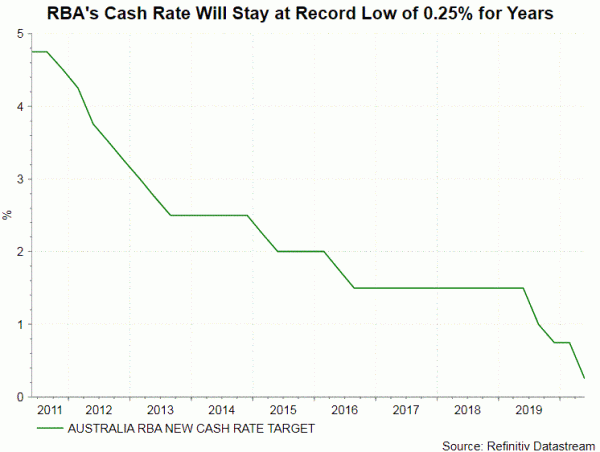We expect RBA to leave its monetary policy measures unchanged in June. Governor Philip Lowe appeared cautiously optimistic about domestic economic outlook. We expect the central bank will deliver a more upbeat economic outlook while pledge to leave the policy rate at record low level for years. The forward guidance will also be maintained, reiterating that RBA will “not increase the cash rate target until progress is being made towards full employment and it is confident that inflation will be sustainably within the 2–3% target band”.
 On economic developments since the last meeting, the job market was hurt by the coronavirus pandemic. The number of payrolls contracted -594K in April, after gaining 700 in the prior month. The market had anticipated a fall of 575K. The unemployment rate increased +1 ppt to 6.2% in April. Yet, this came in much better than consensus of 8.3%. Partly alleviating unemployment was the decline in participation rate, which fell to 63.5% from 66% in March. The market had anticipated a milder drop to 65.2%. There are signs of bottoming out in the labor market.
On economic developments since the last meeting, the job market was hurt by the coronavirus pandemic. The number of payrolls contracted -594K in April, after gaining 700 in the prior month. The market had anticipated a fall of 575K. The unemployment rate increased +1 ppt to 6.2% in April. Yet, this came in much better than consensus of 8.3%. Partly alleviating unemployment was the decline in participation rate, which fell to 63.5% from 66% in March. The market had anticipated a milder drop to 65.2%. There are signs of bottoming out in the labor market.
Speaking before a parliamentary committee, Governor Philip Lowe also sent an upbeat message. As he suggested, “with the national health outcomes better than earlier feared, it is possible that the economic downturn will not be severe as earlier thought“. He also took note of some stabilisation in activity since mid-to-late April, adding that the peak-to-trough decline in hours worked forecast in May’s Statement on Monetary Policy was now “hoped to be around 15%”.
At present, RBA’s major monetary policy includes keeping cash rate at record low of 0.25%, targeting the yield on 3-year Australian Government bonds at 25 bps, and QE. On the monetary policy outlook, Lowe told the parliament that QE could be ramped up “if really needed” while the policy rate will be on hold “for some years”. We expect the central bank will reiterate this stance at the June meeting. It appears that RBA is not enthusiastic about QE. It has already tapered QE in May, citing that economic damage done by the coronavirus pandemic and the corresponding measures is less severe than previously anticipated. In our opinion, the central bank might prefer to do it via rate cut (probably deposit rate) and yield curve targeting if more stimulus is needed.














